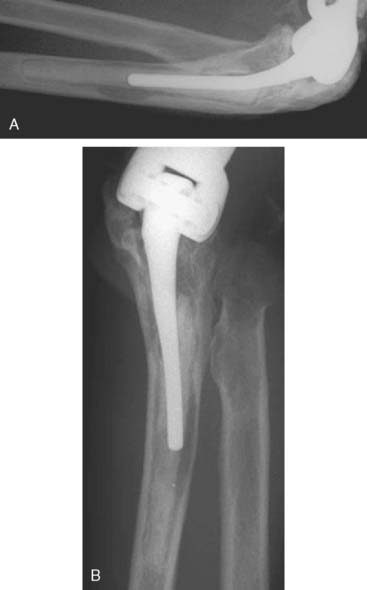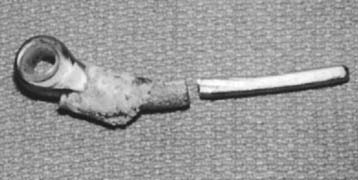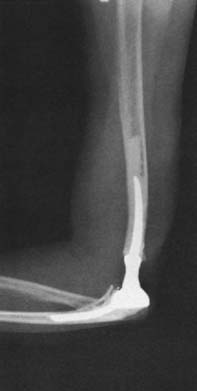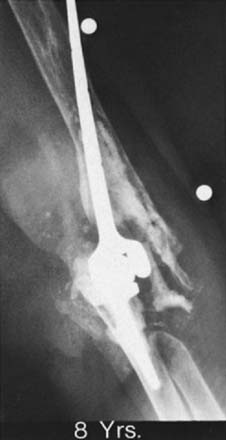CHAPTER 65 Revision of Failed Total Elbow Arthroplasty with Osseous Integrity
INTRODUCTION
A number of surgical options are available to treat failed elbow arthroplasty. In this chapter, we emphasize the indications and the surgical techniques for prosthetic reimplantation of the joint not requiring graft augmentation. Revision requiring osseous augmentation is discussed in the subsequent chapter (Chapter 66). The general problems of reimplantation for failed elbow arthroplasty are placed in perspective of alternate treatment possibilities that are more thoroughly reviewed elsewhere (see Chapters 67 and 69).
CLASSIFICATION OF FAILURE
There are several ways of categorizing failed prior arthroplasty, each with different implications for treatment (Table 65-1).
TABLE 65-1 Revision Options as a Function of Initial Arthroplasty Type and Osseous Integrity
| Index Arthroplasty | Osseous Integrity | Revision Options |
|---|---|---|
| Resection | Variably deficient humerus and/or ulna metaphysis | Insert into mature? bone; may require long flange |
| Fusion | Adequate | Treat as primary arthroplasty |
| Interposition | Adequate | Treat as primary arthroplasty |
| Implant failure |
* Strut and impaction grafting may be combined in some procedures.
Failure of a nonimplantation procedure such as interposition or resection arthroplasty is a relatively straightforward matter, and the treatment and characteristics are no different from those of an acute fracture with bone loss (see Chapters 56 and 57). In this chapter, we deal with failed total elbow arthroplasty with adequate osseous integrity for a direct reimplantation and cementation. In Chapter 66, the options for osseous augmentation are discussed.18,20,24
SEPTIC FAILURE
This is mentioned here to emphasize the need to exclude a septic process as the cause of implant failure. A high index of suspicion must be developed. The value of preoperative screening as with sedimentation rates and C-reactive protein (CRP) is well accepted. One recent study demonstrated a sedimentation rate over 23 mm/hr and a CRP in excess of 13.5 mg/L correlates with infection with a specificity and sensitivity of 85% and 90% respectively.11 Radiolucency of the bone-cement interface may be due to either mechanical failure or sepsis, but implant loosening is not usually associated with a septic joint unless the process is a chronic one.21 Infection of a well-fixed device is particularly bothersome, because removing the prosthesis may result in fracture of bone that poses major reconstructive problems for the surgeon, but commonly sepsis is managed with a staged reimplantation. The important consideration is to avoid excessive use of bone graft in this setting. This topic was reviewed recently by Cheung and colleagues, and is discussed in detail in Chapter 62.3
DEVICE FAILURE
Device failure may involve the stem or the articular coupling elements of the device. High-density polyethylene articular components do have a tendency to wear,15 but this typically does not cause loosening of the implant. Because the semiconstrained implant is being used for broader indications and loosening is much less of a problem, articular wear is increasingly being recognized over long-term follow-up.10,15 Lee et al15 assessed the experience of almost 900 linked Coonrad/Morrey devices. Only 1.5% required reoperation for isolated bushing wear. The authors make the distinction between bushing wear that is managed by simply exchanging the bushing and loosening that typically occurs as a result of loosening and osteolysis that was seen principally in the precoat ulnar component design. This design has not been used for more than 7 years (Fig. 65-1).
Implant fracture is an uncommon complication that usually follows excessive activity or a single significant trauma. This has occurred with the Coonrad-Morrey device owing to the stress-riser effect of the surface treatment of the titanium implant and in patients with excessive physical demands (Fig. 65-2).25
Athwal et al1 reviewed the Mayo experience with fractured components. The technique of removing well-fixed stems and reinsertion into an expansion of the cement mantle was successful in about 80% of patients.
INSTABILITY
With unlinked prostheses, instability is not uncommon (see Chapter 61). Delayed or chronic subluxation is associated with excessive activity, improper initial balance, or implant wear.7,21
If acute instability is due to ligament insufficiency or improper “balance” and does not respond to a period of immobilization, revision with a linked implant should be considered. If early dislocation is due to malpositioning of the components, immediate revision should be performed. In questionable cases, examination under fluoroscopy may show the cause of the instability and allow the management strategy to be defined (Fig. 65-3).
The selection of unlinked implant has been predicated to some extent on the assumption that a reoperation or revision would prove more reliable after this type of design. Until recently, this hypothesis has not been proven. A review of Mayo’s 30-year experience with linked and unlinked implants appears to confirm this assumption but only if the revision was from an unlinked to a linked device (Fig. 65-4).16 Specifically, reoperation of all unlinked implants resulted in a more predictable outcome than did revision after all failed linked implants. However, the linked revisions were to a great extent in patients with post-traumatic arthritis. There was no difference in success of revision when only the rheumatoid patient was considered. Furthermore, it was also demonstrated that the need to revise the unlinked implant occurred at a significantly greater frequency than did the need to reoperate on a linked device (Fig. 65-5).16
LOOSENING
The early experience with total elbow arthroplasty demonstrated loosening of the humeral component about twice as often as loosening of the ulnar component.9,12,21 This difference is not observed with the Coonrad-Morrey device because loosening currently occurs more often at the ulna than at the humerus.4,10,16 Pain is a typical but not a universal feature. Different expressions of failure are recognized. One is a loose implant with pain but few or no x-ray changes and no bone resorption (Fig. 65-6). The other is gross instability and obvious loosening due to bone destruction, with minimal or no pain. Particulate debris results in cortical thinning or “ballooning” of the humerus or the ulna. Resorption of a significant amount of bone can pose major problems with the reconstructive procedure, especially when the bone loss is complicated by fracture (Fig. 65-7). The fracture may be “silent” due to chronic thinning or acute. The latter fracture is not caused by loosening and may heal without a need for implant revision. The topic of periprosthetic fracture is dealt with in detail in Chapter 66 because strut graft is often employed in its treatment.
TREATMENT OPTIONS AND INDICATIONS
As noted earlier, if the failure requires removal of components, treatment possibilities may be categorized according to the integrity of the bone (see Chapter 70), resection (see Chapter 67) and interposition (see Chapter 69). All of these methods may be used to salvage failed prosthetic arthroplasty and are discussed elsewhere. Both reimplantation and nonreimplantation options depend largely on the amount of bone present (Table 65-2). Management of osseous deficiency has been discussed by Sanchez-Sotelo et al,24 and Mansat et al.,20 and is discussed in detail in Chapter 66.
TABLE 65-2 Revision Options as a Function of Bone Stock
| Bone Stock | Options |
|---|---|
| Adequate | Arthrodesis, resection, interposition, total elbow arthroplasty, semiconstrained prosthesis |
| Inadequate | Resection, allograft, total elbow arthroplasty, semiconstrained (long-flanged) prosthesis composite (total elbow arthroplasty with allograft), custom-made prosthesis |
INTERPOSITION ARTHROPLASTY
Several types of interposition arthroplasty are described, which, if they fail, may be revised depending on the amount and quality of available bone, and the presence of sepsis. Chapter 60 discusses interposition arthroplasty, and Chapter 67 reviews nonimplantation salvage procedures for failed elbow replacement. Blaine et al2 reviewed the Mayo experience of revising failed interposition arthroplasty with the linked total elbow implant. The average Mayo elbow performance score increased from 32 to 80.4 points. The authors reported 9 of 12 (75%) satisfactory outcomes with elbow replacement following failed interposition arthroplasty.
REIMPLANTATION PROCEDURES
General Considerations
Stay updated, free articles. Join our Telegram channel

Full access? Get Clinical Tree















